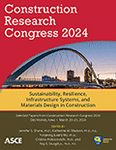Deciding Infrastructure Reconstruction Priorities after Disasters: A Literature Review
Publication: Construction Research Congress 2024
ABSTRACT
Disaster reconstruction is costly, and given limited resources, prioritization of the most critical infrastructure elements is necessary. This paper summarizes a literature review exploring how post-disaster reconstruction is performed on a macro-level, meaning the integrated nature of multiple infrastructure systems. This research specifically focused on determining how decision analysis is carried out in real-time application and how those decisions may be influenced by the growing body of knowledge on reconstruction decision making analysis and optimization techniques. The literature reports many different processes that have been developed for prioritizing infrastructure reconstruction, including a number of academic models designed to aid prioritization efforts. For their part, governments and managers of infrastructure systems are making prioritization decisions as disasters strike, but it is unknown whether or not real-world decision-making routinely incorporates these academic prioritization strategies. These results will help inform further research in developing macro-level interdisciplinary decision-making models for effectively prioritizing infrastructure reconstruction.
Get full access to this article
View all available purchase options and get full access to this chapter.
REFERENCES
Afkhamiaghda, M., and E. Elwakil. 2022. “Challenges review of decision making in post-disaster construction.” Int. J. of Construction Management, 1–10. Taylor & Francis.
Bensi, M. T. 2010. A Bayesian network methodology for infrastructure seismic risk assessment and decision support. Doctoral Dissertation. University of California, Berkeley.
Bocchini, P., and D. M. Frangopol. 2012. “Optimal resilience-and cost-based postdisaster intervention prioritization for bridges along a highway segment.” J. of Bridge Eng., 17 (1): 117–129. ASCE.
FEMA. 2011. National Disaster Recovery Framework: Strengthening Disaster Recovery for the Nation. Federal Emergency Management Agency.
FEMA. 2022. National Preparedness Report. Federal Emergency Management Agency.
FEMA. 2023. National Risk Index. Federal Emergency Management Agency. https://hazards.fema.gov/nri/.
Fengler, W., A. Ihsan, and K. Kaiser. 2008. Managing Post-Disaster Reconstruction Finance. World Bank Publications.
Freeman, P., L. A. Martin, J. Linnerooth-Bayer, R. Mechler, G. Pflug, and K. Warner. 2003. Disaster Risk Management. Inter-American Development Bank.
Ghannad, P., and Y.-C. Lee. 2020. “Prioritization of post-disaster reconstruction of transportation network using an integrated AHP and genetic algorithm.” CRC 2020: Project Management and Controls, Materials, and Contracts, 464–474. ASCE.
Ghannad, P., Y.-C. Lee, C. Friedland, and E. Yang. 2019. “Optimizing the socioeconomic benefit of post-disaster strategies by prioritizing reconstruction of damaged facilities.” Computing in Civil Eng. 2019: Smart Cities, Sustainability, and Resilience, 180–187. ASCE.
Goujon, B., and C. Labreuche. 2015. “Use of a multi-criteria decision support tool to prioritize reconstruction projects in a post-disaster phase.” 2nd International Conf. on Information and Communication Technologies for Disaster Management (ICT-DM), 200–206. IEEE.
Ho, H. W., and A. Sumalee. 2014. “Optimal recovery plan after disaster: Continuum modeling approach.” J. of Transportation Engineering, 140 (8): 04014034. ASCE.
Hwang, S., M. Park, H.-S. Lee, S. Lee, and H. Kim. 2015. “Postdisaster interdependent built environment recovery efforts and the effects of governmental plans: Case analysis using system dynamics.” J. of Construction Eng. and Management, 141 (3): 04014081. ASCE.
Insurance Information Institute. 2023. Facts + Statistics: U.S. catastrophes. https://www.iii.org/fact-statistic/facts-statistics-us-catastrophes.
Karamlou, A., and P. Bocchini. 2014. “Optimal bridge restoration sequence for resilient transportation networks.” Structures Congress 2014, 1437–1447. ASCE.
Kitchenham, B. 2004. Procedures for performing systematic reviews. Keele University.
Kulatunga, U. 2011. “Project management of disaster reconstruction.” Post‐Disaster Reconstruction of the Built Environment: Rebuilding for Resilience, 133–150. Wiley.
Lambert, J. H., C. W. Karvetski, D. K. Spencer, B. J. Sotirin, D. M. Liberi, H. H. Zaghloul, J. B. Koogler, S. L. Hunter, W. D. Goran, and R. D. Ditmer. 2012. “Prioritizing infrastructure investments in Afghanistan with multiagency stakeholders and deep uncertainty of emergent conditions.” J. of Infrastructure Systems, 18 (2): 155–166. ASCE.
Lu, Y., and J. Xu. 2015. “Comparative study on the key issues of postearthquake recovery and reconstruction planning: Lessons from the United States, Japan, Iran, and China.” Natural Hazards Review, 16 (3): 04014033. ASCE.
Main, J. A., et al. 2021. Learning from Hurricane Maria’s Impacts on Puerto Rico: A Progress Report. National Institute of Standards and Technology.
Nazif, S., and M. Karamouz. 2009. “Algorithm for assessment of water distribution system’s readiness: planning for disasters.” J. of Water Resources Planning and Management, 135 (4): 244–252. ASCE.
Oh, E. H., A. Deshmukh, and M. Hastak. 2013. “Criticality assessment of lifeline infrastructure for enhancing disaster response.” Natural Hazards Review, 14 (2): 98–107. ASCE.
Orabi, W., K. El-Rayes, A. B. Senouci, and H. Al-Derham. 2009. “Optimizing postdisaster reconstruction planning for damaged transportation networks.” J. of Construction Engineering and Management, 135 (10): 1039–1048. ASCE.
Orabi, W., A. B. Senouci, K. El-Rayes, and H. Al-Derham. 2010. “Optimizing resource utilization during the recovery of civil infrastructure systems.” J. of Management in Eng., 26 (4): 237–246. ASCE.
Rebuilding Task Force. 2013. Hurricane Sandy Rebuilding Strategy. Hurricane Sandy Rebuilding Task Force.
Rouhanizadeh, B., and S. Kermanshachi. 2019. “Investigating the relationships of socioeconomic factors delaying post-disaster reconstruction.” Computing in Civil Eng. 2019: Smart Cities, Sustainability, and Resilience, 33–40. ASCE.
Rouhanizadeh, B., and S. Kermanshachi. 2020. “Post-disaster reconstruction of transportation infrastructures: Lessons learned.” Sustainable Cities and Society, 63: 102505. Elsevier.
Zamanifar, M., and T. Hartmann. 2020. “Optimization-based decision-making models for disaster recovery and reconstruction planning of transportation networks.” Natural Hazards, 104: 1–25. Springer.
Information & Authors
Information
Published In
History
Published online: Mar 18, 2024
Authors
Metrics & Citations
Metrics
Citations
Download citation
If you have the appropriate software installed, you can download article citation data to the citation manager of your choice. Simply select your manager software from the list below and click Download.
